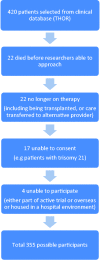Medication and patient factors associated with adherence to pulmonary hypertension targeted therapies
- PMID: 29099657
- PMCID: PMC5731720
- DOI: 10.1177/2045893217743616
Medication and patient factors associated with adherence to pulmonary hypertension targeted therapies
Abstract
The aims of this study were to investigate the medication adherence of patients on pulmonary hypertension (PH)-targeted therapies and uncover factors that might influence adherence values. Patients taking at least one specialist medicine (sildenafil, tadalafil, bosentan, ambrisentan, iloprost, epoprostenol, treprostinil) completed a Morisky Medication Adherence Scale-8 (MMAS-8) questionnaire. Participants' MMAS-8 scores were used to estimate overall medicine adherence. Potential adherence co-factor data were collected from patient databases and hospital discharge summaries. The MMAS-8 questionnaire was completed by 263 patients (mean age = 61.6 ± 14.8 years, 70.6% women). Data from MMAS-8 showed that 47.9% reported high adherence, 40.3% moderate adherence, and 11.8% low adherence. Factors associated with adherence as measured by the MMAS-8 included: older age; taking monotherapy; and having a higher number of co-morbidities or concurrent medicines. Higher administration frequency, greater length of time on targeted therapy, and use of a compliance aid had a negative association with adherence. Overall adherence to PH specialist medicines is relatively high but a proportion of patients report sub-optimal adherence behavior. A number of factors may help to recognize susceptible patients.
Keywords: MMAS-8; Morisky; compliance; concordance; medicines.
Figures
References
-
- Humbert M, Sitbon O, Simonneau G. Treatment of pulmonary arterial hypertension. N Engl J Med 2004; 351: 1425–36. - PubMed
-
- D’Alonzo GE, Barst RJ, Ayres SM, et al. Survival in patients with primary pulmonary hypertension. Results from a national prospective registry. Ann Intern Med 1991; 115: 343–349. - PubMed
-
- Health and Social Care Information Centre. Pulmonary Hypertension Association UK, National Pulmonary Hypertension Centres of the UK and Ireland Physicians Committee, NHS England, National Services Division Scotland, Welsh Health Specialised Services Committee. National Audit of Pulmonary Hypertension 2014, Leeds: HSCIC, 2015.
-
- NHS England. Clinical Commissioning Policy: National policy for targeted therapies for the treatment of pulmonary hypertension in adults, London: NHS England, 2014.
LinkOut - more resources
Full Text Sources
Other Literature Sources



